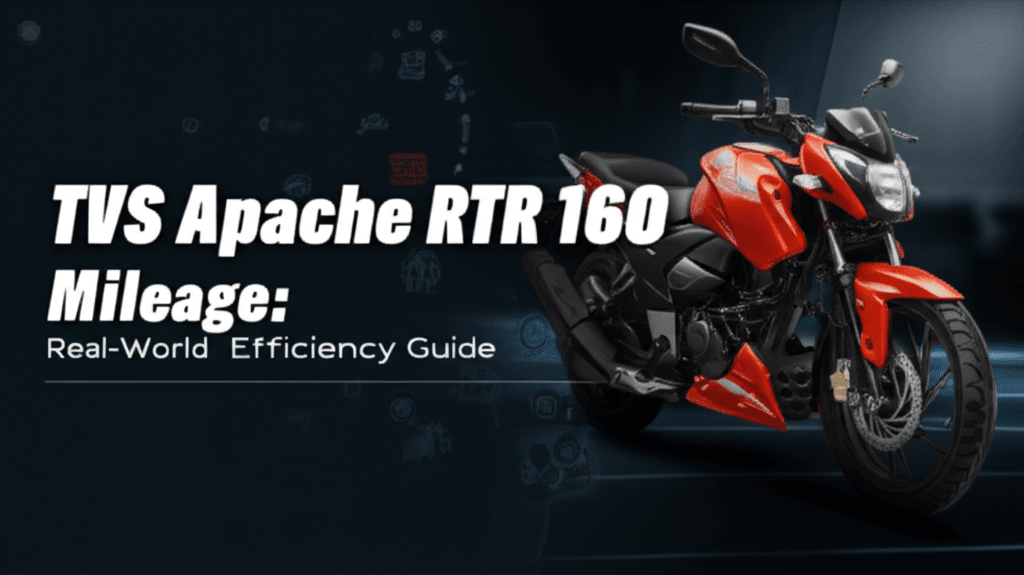TVS Apache RTR 160 is a popular commuter-sport motorcycle trusted for its punchy performance, agile handling, and competitive fuel efficiency. If you’re considering buying one or you already own it and want to maximize its mileage, this comprehensive guide breaks down everything you need to know. From real-world mileage in city and highway conditions to factors affecting fuel consumption, maintenance practices, riding techniques, and cost-per-kilometer insights, you’ll find practical, actionable tips that help you save fuel while enjoying the RTR’s sporty character.
Understanding TVS Apache RTR 160 Mileage
The Apache RTR 160 has been offered in various iterations over the years, including carbureted and fuel-injected versions, BS4 and BS6 models, and even the RTR 160 2V and RTR 160 4V lines. While performance and refinement have evolved, the essence of the bike—a balance between sporty dynamics and everyday usability—remains consistent. Mileage, however, can vary based on engine tuning, emission norms, and riding conditions.
Claimed vs Real-World Mileage
Manufacturers typically provide a claimed mileage under standardized test cycles. In the real world, factors like traffic, riding style, and maintenance make a noticeable difference.
- Claimed efficiency (varies by version and market): Approximately 45–50 km/l for newer BS6 iterations under ideal conditions.
- Real-world city mileage: 38–45 km/l for most riders, depending on traffic intensity and load.
- Real-world highway mileage: 45–55 km/l at steady speeds (typically 55–65 km/h in top gear).
Key takeaway: Riders who maintain smooth throttle control, timely maintenance, and proper tire pressure consistently report better-than-average mileage figures.
Different Variants and Their Fuel Efficiency
The RTR 160 family includes multiple variants that influence efficiency:
- RTR 160 2V (Carb/EFI): Earlier models can return 40–48 km/l depending on tune and maintenance.
- RTR 160 2V BS6 (EFI): More refined fueling, often delivers 42–50 km/l in mixed use.
- RTR 160 4V (BS6): Slightly more performance-oriented; real-world efficiency often falls in the 38–48 km/l range due to higher output, though careful riding can still achieve 50+ km/l on highways.
Note: Actual mileage depends on location, fuel quality, altitude, traffic, and individual riding habits.
Real-World Mileage: City vs Highway vs Mixed Use
Mileage differs across riding environments. To help you set realistic expectations, here’s how the RTR 160 typically performs in varied scenarios.
City Riding Conditions
In dense urban traffic with frequent stops, the engine spends time idling and operating in lower gears. This tends to lower efficiency.
- Average city mileage: 38–45 km/l
- Peak-hour traffic: Expect 35–40 km/l
- Moderate traffic and smooth roads: 42–47 km/l
Tips to improve city mileage:
- Use progressive throttle inputs—avoid sudden acceleration.
- Shift early but not too low—keep the engine in its efficient RPM band (usually 3,000–5,000 rpm for cruising).
- Anticipate traffic lights to reduce unnecessary braking and re-acceleration.
- Minimize idling above 30 seconds; turn off the engine if safe.
Highway Riding Conditions
On open roads, consistent speed and fewer gear changes promote fuel efficiency.
- Average highway mileage: 45–55 km/l
- Optimal cruising speed: 55–65 km/h in top gear
- High-speed runs (80–100 km/h): Expect mileage to drop to 38–45 km/l due to aerodynamic drag and higher RPM.
Tips for better highway mileage:
- Maintain a steady speed; use engine torque rather than frequent downshifts.
- Ensure correct tire pressure and well-lubricated chain.
- Travel light; reduce luggage and avoid boxy add-ons.
- Use ethanol-balanced fuel if available and recommended.
Mixed Use (Suburban/Peri-Urban)
Many riders experience mixed conditions: brief city commutes with highway stretches.
- Typical mixed mileage: 42–50 km/l
- Weekend rides (light traffic): Up to 50–55 km/l with conservative riding.
Bottom line: The RTR 160 delivers a strong balance of performance and fuel efficiency, especially when ridden smoothly and maintained diligently.
Factors That Affect Apache RTR 160 Fuel Efficiency
Several variables determine how far each liter of fuel takes you. Understanding these can help you fine-tune your routine and get consistent results.
Riding Style and Behavior
- Throttle discipline: Abrupt acceleration and aggressive riding significantly reduce mileage.
- Gear selection: Short shifting too early can lug the engine; over-revving wastes fuel. Aim for the engine’s sweet spot.
- Idling habits: Long idling drains fuel without progress.
- Load and pillion: Carrying a pillion or heavy cargo increases rolling resistance and fuel burn.
Maintenance and Vehicle Condition
- Air filter cleanliness: A clogged air filter enriches the mixture and reduces mileage.
- Spark plug health: Worn plugs lead to incomplete combustion.
- Engine oil quality and grade: Old or wrong-grade oil increases friction.
- Chain lubrication and tension: A dry or tight chain consumes more power.
- Brake drag: Misaligned or dragging brakes sap efficiency.
Fuel Quality and Type
- Octane rating: Use manufacturer-recommended fuel; premium fuel rarely improves economy unless specifically advised.
- Ethanol blend: Higher ethanol content slightly reduces energy density; you might see 1–3% lower mileage with E20 compared to E0/E10.
- Contaminants: Poor-quality fuel can clog injectors or jets, lowering efficiency.
Tire Pressure and Rolling Resistance
- Under-inflation: Reduces mileage by up to 5–8% while increasing tire wear.
- Over-inflation: Improves mileage marginally but compromises grip and comfort.
Ideal practice: Check tire pressure weekly when cold, and follow TVS’s recommended PSI for solo and pillion riding.
Environmental and Route Factors
- Traffic density: Start-stop traffic is the biggest mileage killer.
- Terrain and altitude: Hilly routes demand more power; thin air at altitude can affect fueling and performance.
- Weather: Strong headwinds increase drag. Very hot or cold conditions influence fuel vaporization and tire pressures.
How to Improve TVS Apache RTR 160 Mileage
Even if your base mileage is satisfactory, a few disciplined habits can consistently add 3–8 km/l to your figures.
Riding Techniques That Work
- Smooth throttle application: Roll on gently; avoid snapping the throttle open.
- Optimal shift points: Shift up around 4,000–5,000 rpm during calm rides; avoid lugging below 2,500–3,000 rpm in higher gears.
- Use momentum: Anticipate traffic; coast gently when possible instead of accelerating and braking repeatedly.
- Cruise consistently: On highways, pick a speed and stick with it; frequent speed changes burn extra fuel.
Maintenance Checklist for Better Efficiency
- Service intervals: Follow TVS’s schedule for oil changes, filter replacements, and inspections.
- Air filter: Clean or replace at recommended intervals; dusty environments may require more frequent cleaning.
- Spark plug: Inspect gap and carbon deposits; replace if worn.
- Injector/carb health: Periodically clean injectors or carburetor jets to maintain optimal atomization.
- Chain: Lube every 500–700 km, sooner in rain or dust; maintain proper slack.
- Wheel alignment and bearings: Ensure free rolling; fix any binding or wobble.
Fuel and Consumables
- Quality fuel stations: Prefer reputed pumps with consistent throughput.
- Recommended oil grade: Use the manufacturer-specified viscosity; synthetic or semi-synthetic can reduce friction and stabilize performance.
- Additives: Use only manufacturer-approved injectors/carb cleaners; avoid unverified additives.
Weight and Aerodynamics
- Travel light: Remove unnecessary racks, boxes, or heavy accessories.
- Riding posture: A slightly tucked, relaxed posture reduces wind drag at speed.
Cost per Kilometer: Apache RTR 160 Ownership Economics
Understanding mileage translates directly into running costs. Here’s a practical way to estimate your cost-per-kilometer based on typical fuel prices and usage.
Sample Calculations
Assumptions for illustration:
- Fuel price: ₹110 per liter (adjust for your location)
- City mileage: 40 km/l
- Highway mileage: 50 km/l
City cost per km: 110 / 40 = ₹2.75/km
Highway cost per km: 110 / 50 = ₹2.20/km
If your mixed mileage is 45 km/l, your average running cost is about ₹2.44/km. Over 1,000 km a month, that’s roughly ₹2,440 on fuel alone. Add routine maintenance, tires, and consumables for a full Total Cost of Ownership (TCO) view.
Ways to Lower TCO
- Preventive maintenance: Avoid costly repairs by servicing on time.
- Fuel-efficient riding: Save 5–10% on fuel over a year with disciplined habits.
- Tire care: Proper inflation extends tire life and saves fuel.
Apache RTR 160 Mileage Compared with Rivals
Riders often cross-shop the RTR 160 with other 150–160 cc commuters and sporty commuters. While exact figures vary by region and model year, this comparison outlines typical real-world trends.
| Model | Typical City (km/l) | Typical Highway (km/l) | Notes |
|---|---|---|---|
| TVS Apache RTR 160 2V (BS6) | 38–45 | 45–55 | Balanced efficiency with sporty edge |
| TVS Apache RTR 160 4V (BS6) | 38–44 | 44–52 | More power; slightly lower economy if ridden hard |
| Bajaj Pulsar 150/160 | 40–48 | 45–55 | Known for frugal engines in steady rides |
| Honda Unicorn/CB series 160 | 42–50 | 48–58 | Smooth engine; efficiency-focused tuning |
| Yamaha FZS/FZ 150–160 | 40–47 | 45–55 | Refined, sometimes slightly lower top-end economy |
Interpretation: The RTR 160 competes strongly, especially when considering its performance-per-liter ratio. If pure efficiency is your top priority, gentler throttle inputs and timely maintenance will help the RTR match the best of the segment.
Practical Examples and Real-World Applications
To ground these insights, here are scenarios that show how small choices shift outcomes.
Daily Commuter Example
Profile: 22 km daily commute, 70% city, 30% suburban roads.
- Riding style: Moderate, early shifts, minimal idling.
- Maintenance: On schedule; chain lubed weekly; tire pressures checked.
- Outcome: 44–48 km/l consistently, even during peak hours on most days.
Weekend Touring Example
Profile: 200 km weekend ride, highway and state highways.
- Riding style: Steady 60–70 km/h cruising; occasional overtakes.
- Load: Light luggage, solo rider.
- Outcome: 50–55 km/l achievable, with comfortable range between fuel stops.
Performance-Oriented Rider Example
Profile: Spirited rides with frequent acceleration; mixed terrain.
- Riding style: Higher RPM shifts, strong throttle inputs.
- Outcome: 35–42 km/l; efficiency drops as pace increases.
Maintenance Impact Example
Before: Overdue oil change, clogged air filter, slack chain. Mileage: ~38 km/l (city).
After: Fresh oil, cleaned filter, correct chain tension, tire pressure set. Mileage: ~44 km/l (city).
Gain: ~15% improvement with routine maintenance alone.
Riding and Maintenance Checklist for Best Mileage
Use this repeatable checklist to keep your RTR 160 at peak efficiency.
Weekly Checklist
- Tire pressures: Check and adjust when cold.
- Chain: Inspect lubrication and slack; clean/lube if dirty or after rain.
- Brakes: Ensure no dragging; listen for rubbing sounds.
Monthly Checklist
- Air filter: Inspect and clean if dusty.
- Fasteners & controls: Tighten loose bolts, adjust clutch free play for smooth engagement.
- Fuel economy log: Track km/l to catch issues early.
Service Interval Tasks
Engine oil and filter: Replace per TVS

